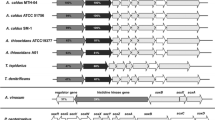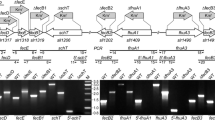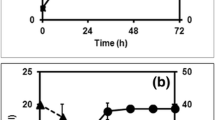Abstract
Chemolithotrophic sulfur oxidation (Sox) in the α-proteobacterium Pseudaminobacter salicylatoxidans KCT001 was found to be governed by the gene cluster soxSRT–soxVWXYZABCD. Independent transposon-insertion mutations in the genes soxB, soxC, soxD, and also in a novel open reading frame (ORF), designated as soxT, afforded revelation of the entire sox locus of this bacterium. The deduced amino acid sequence of the novel ORF soxT comprised 362 residues and exhibited significant homology with hypothetical proteins of diverse origin, including a permease-like transport protein of Escherichia coli. Two contiguous ORFs, soxR and soxS, immediately preceded the soxT gene. The gene cluster soxSRT was located upstream of soxVWXYZABCD and was transcribed divergently with respect to the latter. Chemolithotrophic utilization of both thiosulfate and tetrathionate was observed to have been impaired in all of these Sox− mutants, implicating the involvement of the gene cluster soxSRT–soxVWXYZABCD in the oxidation of both thiosulfate and tetrathionate.



Similar content being viewed by others
Literature Cited
Altschul SF, Madden TL, Schaffer AA, Zhang J, Zhang Z, Miller W, et al. (1997) Gapped BLAST and PSI-BLAST: a new generation of protein database search programs. Nucleic Acids Res 25:3389–3402
Appia-Ayme C, Berks BC (2002) SoxV, an orthologue of the CcdA disulfide transporter, is involved in thiosulfate oxidation in Rhodovulum sulfidophilum and reduces the periplasmic thioredoxin SoxW. Biochem Biophys Res Commun 296:737–741
Appia-Ayme CP, Little J, Matsumoto Y, Leech AP, Berks BC (2001) Cytochrome complex essential for photosynthetic oxidation of both thiosulfate and sulfide in Rhodovulum sulfidophilum. J Bacteriol 183:6107–6118
Bagchi A, Roy D, Roy P (2005) Homology modeling of a transcriptional regulator SoxR of the lithotrophic sulfur oxidation (Sox) operon in α-proteobacteria. J Biomol Struct Dyn 22:571–578
Bairoch A (1993) A possible mechanism for metal-ion induced DNA-protein dissociation in a family of prokaryotic transcriptional regulators. Nucleic Acids Res 21:2515
Bardischewsky F, Friedrich CG (2001) The shxVW locus is essential for oxidation of inorganic sulfur and molecular hydrogen by Paracoccus pantotrophus GB17: a novel function for lithotrophy. FEMS Microbiol Lett 202:215–220
Bullock WO, Fernandez JM, Short JM (1987) XL1-Blue: A high efficiency plasmid transforming recA Escherichia coli strains with beta-gatactosidase selection. Bio Techniques 5:376–378
Combet CC, Blanchet C, Geourjon, Deléage G (2000) NPS@: Network protein sequence analysis. Trends Biochem Sci 25:147–150
Deb C, Stackebrandt E, Padella S, Saha A, Roy P (2004) Phylogenetically diverse new sulfur chemolithotrophs of α-proteobacteria isolated from Indian soils. Current Microbiol 48:452–458
Devereux JP, Haeberli P, Smithies O (1984) A comprehensive set of sequence analysis programs for the VAX. Nucleic Acids Res 12:387–395
Friedrich CG, Quentimeier A, Bardischeavsky F, Rother D, Kraft R, Kostka S, et al (2000) Novel genes coding for lithotrophic sulfur oxidation of Paracoccus pantotrophus GB17. J Bacteriol 182:4677–4687
Friedrich CG, Rother D, Bardischewsky F, Quentmeier A, Fischer J (2001) Oxidation of reduced sulfur compounds by bacteria: Emergence of a common mechanism? Appl Environ Microbiol 67:2873–2882
Hall TA (1999) BioEdit: A user-friendly biological sequence alignment editor and analysis programme for Windows 95/98/NT. Nucleic Acids Symp Ser 41:95–98
Hayashi T, Makino K, Ohnishi M, et al. (2001) Complete genome sequence of enterohemorrhagic Escherichia coli O157: H7 and genomic comparison with a laboratory strain K-12. DNA Res 8:11–22
Hensel M, Hinsley AP, Nikolaus T, Sawers G, Berks BC (1999) The genetic basis of tetrathionate respiration in Salmonella typhimurium. Mol Microbiol 32:275–287
Kaneko T, Nakamura Y, Sato S, et al. (2002) Complete genomic sequence of nitrogen-fixing symbiotic bacterium Bradyrhizobium japonicum. USDA110 9:189–197
Kelly DP, Wood A (1994) Synthesis and determination of thiosulfate and polythionates. Methods Enzymol 243:475–501
Marchler-Bauer A, et al. (2003) CDD: A curated Entrez database of conserved domain alignments. Nuclei Acids Res 31:383–387
Marmur J (1961) A procedure for the isolation of deoxyribonucleic acid from microorganisms. J Mol Biol 3:208–218
Miller JH (1972) Experiments in molecular genetics. Cold Spring Harbor Laboratory Press, Cold Spring Harbor, NY
Mukhopadhyaya PN, Deb C, Lahiri C, Roy P (2000) A soxA gene, encoding a diheme cytochrome c, and a sox locus, essential for sulfur oxidation in a new sulfur lithotrophic bacterium. J Bacteriol 182:4278–4287
Rice P, Longden I, Bleasby A (2000) EMBOSS: The European molecular biology open software suite. Trends Genet 16:267–277
Rother D, Henrich HJ, Quentmeier A, Bardischewsky F, Friedrich CG (2001) Novel genes of the sox gene cluster, mutagenesis of the flavoprotein SoxF, and evidence for a general sulfur oxidizing system in Paracoccus pantotrophus GB17. J Bacteriol 183:4499–4508
Sambrook J, Maniatis T, Fritsch EF (1989) Molecular cloning A laboratory manual. 2nd edn Cold Spring Harbor Laboratory Press, Cold Spring Harbor, NY
Steudel R (1989) On the nature of the “elemental sulfur” (S0) produced by sulfur-oxidizing bacteria—A model for S0 globules. In: Schlegel HG, Bowen B (eds) Autotrophic bacteria. Science Tech, Madison, WI pp 289–303
Thompson JD, Higgins DG, Gibson TJ (1994) CLUSTALW: Improving the sensitivity of progressive multiple sequence alignment through sequence weighting position-specific gap penalties and weight matrix choice. Nucleic Acids Res 22:4673–4680
Acknowledgments
The assistance provided by Biswanath De Sarkar and Nityananda Patra is acknowledged. This work was supported by the Council of Scientific and Industrial Research, Government of India, Extramural Research Unit-II, under Project No. 37/1091/02-EMR-II. S. M. and B. D. were supported by C. S. I. R. fellowships.
Author information
Authors and Affiliations
Corresponding author
Additional information
Pradosh Roy Deceased
Rights and permissions
About this article
Cite this article
Lahiri, C., Mandal, S., Ghosh, W. et al. A Novel Gene Cluster soxSRT Is Essential for the Chemolithotrophic Oxidation of Thiosulfate and Tetrathionate by Pseudaminobacter salicylatoxidans KCT001. Curr Microbiol 52, 267–273 (2006). https://doi.org/10.1007/s00284-005-0176-x
Received:
Accepted:
Published:
Issue Date:
DOI: https://doi.org/10.1007/s00284-005-0176-x




